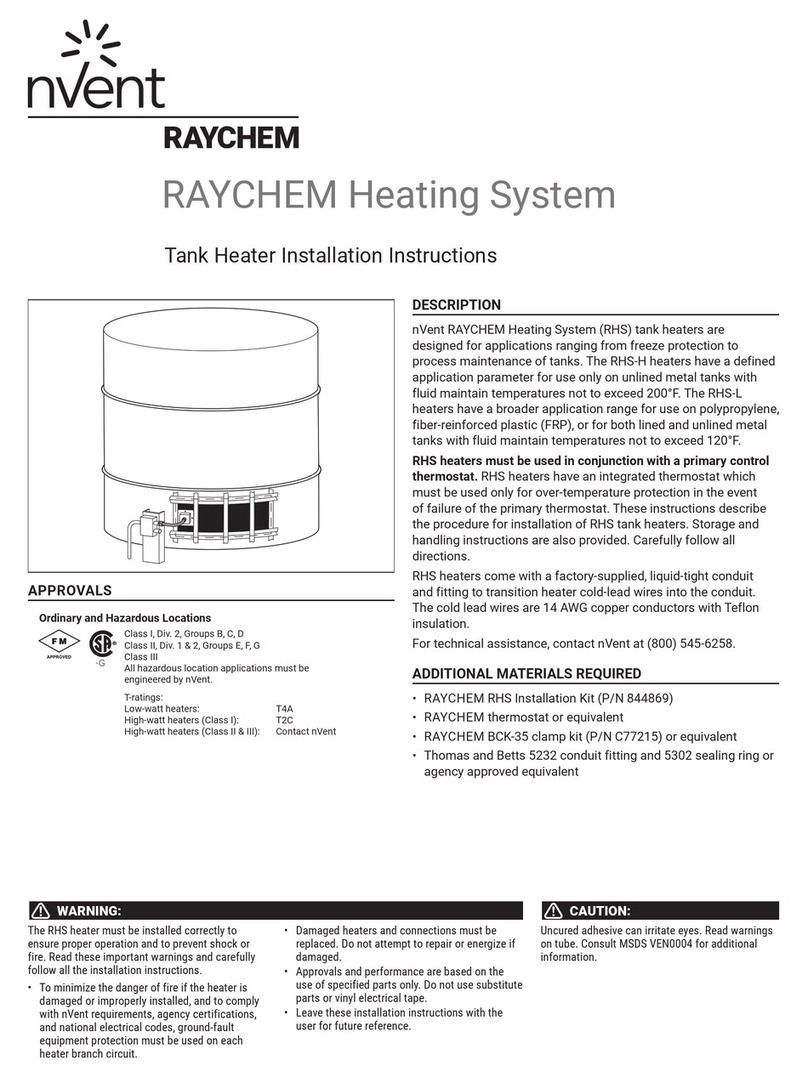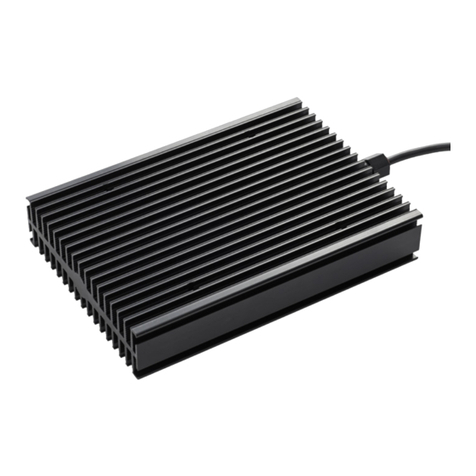
DESCRIPTION
The nVent RAYCHEM Hopper Heating System Wrap-Wound Heater
(HHS-WWH) is designed for the poke tube and throat portions of
Electrostatic Precipitator (ESP) hoppers, baghouse hoppers and
material / dust-collector hoppers and is intended to complement the
HHS heater modules.
It is highly recommended for all HHS-WWH heaters to be used in
conjunction with a temperature control device. These instructions
describe the procedure for installation, storage and handling of
HHS-WWH heaters. Carefully follow all directions.
The HHS-WWH heater must be
installed correctly to ensure proper
operation and to prevent shock
or fire. Read these important
warnings and carefully follow all the
installation instructions.
• All electrical wiring must follow
local electrical codes. Ground fault
equipment protection must be used
on each heater branch circuit to mini-
mize the danger of re if the heater
is damaged or improperly installed
and to comply with nVent design
requirements, agency certications
and national electrical codes.
• Damaged heaters and connections
must be replaced. Do not attempt to
repair or energize if damaged. Only
qualied personnel are allowed to
connect electrical wiring. Disconnect
all supply power at the source before
making any power connections. It is
highly recommended to never oper-
ate heaters without a temperature
control device.
• The end-user is responsible for
providing a suitable disconnecting
device.
• The end-user is responsible for
providing a suitable electrical
protection device.
• Final installation / wiring is to be
inspected by the authority who
has jurisdiction in the area that the
heater is installed.
• Approvals and performance are
based on the use of specified parts
only. Do not use vinyl electrical
tape or substitute parts.
• Read and understand this entire
manual before operating this elec-
tric heater. Leave these installation
instructions with the user for future
reference.
• Failure to observe these warnings
may result in personal injury or
damage to the heater.
Read and understand this entire manual before operating or servicing these heaters. Failure to understand how to
safely operate these heaters could result in an accident causing serious injury or death. These heaters should only be
operated by qualified personnel and any individual who has not read and understood all installation instructions is not
qualified to install this product. Additional copies of this manual are available upon request.
WARNING:
WARNING: CAUTION:
• Never handle the heater while it is in operation; always
disconnect the heater from the power source and allow
for proper cooling prior to handling.
• Inspect heater before use and do not use a heater with
torn or worn surfaces.
• If spillage of foreign matter onto the heater occurs,
disconnect from the power source and clean after the
heater is allowed to cool.
• Never operate a heater without an appropriate heat
sink. (Device being heated is considered a heat sink).
• Do not operate the heater above the rated temperature
value.
• Fasten the heater to the heated surface using approved
methods only.
• Do not repair damaged or faulty heaters.
• Do not crush or apply severe physical stress on the
heater or lead wire assembly.
• Avoid hazards or unsafe practices which could result in
personal injury or property damage.
LIMITED WARRANTY
nVent offers 1 year limited standard warranty for the RAYCHEM
HHS-WWH.
ADDITIONAL / OPTIONAL MATERIALS REQUIRED
• Cleaning / prep supplies
• Wire ties
• Junction box
• Temperature controller and sensor
• Insulating materials
SAFETY ALERT SYMBOL
The symbol above is used to call your attention to instructions
concerning your personal safety. It points out important safety
precautions. It means “ATTENTION! Become Alert! Your Personal
Safety is involved!” Read the message that follows and be alert to
the possibility of personal injury.
HHS-WWH PRODUCT SPECIFICATIONS
Power density Standard wattages up to 4650 W/m²
(3.0 W/in²)
Voltage range (nominal) 120 to 600 VAC
Maximum exposure
temperature
760ºC (1400ºF)
Maximum maintain
temperature (power on)
500°C (932°F)
Minimum installation
temperature
–20ºC (–4ºF)
Typical heater set point 120-150ºC (248-300ºF)
Dielectric strength Up to 2,200 VAC
Power leads* 5.0m (16 ft.) long, moisture resistant,
high-temperature stainless steel overbraid
with a standard heater ground wire
* Lead wire length can be customized to align with the project
design requirements.
HHS-WWH
Hopper Heating System – Wrap-Wound Heater Installation
Instructions


























